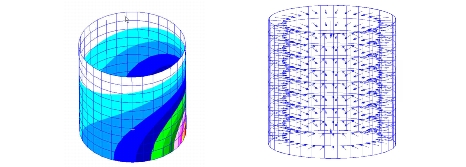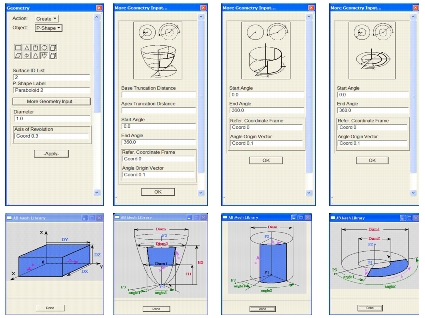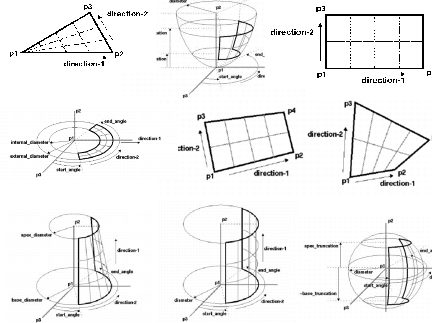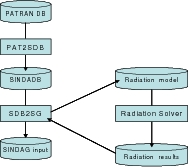XXXXXXXXXXXXXXXXXXXXXXXXXXXXXXXXXXXXXXXXXXXXXXXXXXXXXXXXXXXXXXXXXXXXXXXXXXXXXXXXXXXXXXXXXXXXXXXXXXXXXXXXXXXXXXXXXXXXXXXXXXXXXXXXXXXXXXXXXXXXXXXXXXXXXXXX''"> Super Element
The radiation super element method uses a nodal group concept in radiation codes. A nodal group may consist of many radiation nodes. In the radiation model, a nodal group will be treated as one single node, just like one element in radiation model. The nodal group in radiation model is called radiation super element in the FEM model.
In the above two cases, there is one radiation conductor between surface1 and surface2. By using the nodal group concept, we can also calculate a radiation conductor between group1 and group2. These two radiation conductors should be the same. In the two group radiation model, what we need is to develop a method to distribute one radiation conductor from “one to one” to “many to many”.
If we set the ray tracing count number equal to 5000, then the first model will trace only 2 x 5000 rays. For the second model, if we use the super element method, also 2 x 5000 rays are traced, but we will need a little more time to distribute the radiation conductor. If we use the traditional FEM method (small facets method), 25 x 25 x 5000 rays are traced which is much slower.
However, when the super element method is used, all the small facets inside one super element will “share” the ray tracing count based on area weights. In the two group radiation model, each small facet will emit only 5000/25 = 200 rays. This is why the super element method is much faster than small facets method. The radiation result accuracy is relative with emitted ray amount form each surface. The super element, as a whole, emits the same amount rays as other small facets, therefore it has the same accuracy. It does not affect the accuracy of the whole model.
To prove this, suppose a cylinder surface is created in PATRAN and meshed into 310 elements. Two disc surfaces are added to the top and bottom to form an enclosure. The following 3 models are based on this example. NEVADA is used to calculate the radiation exchange factors. The emitting ray number is 500,000 for the 3 models.
Model 1: a cylinder surface (node 1) + 2 round surfaces (node 2,3)
Model 2: 310 small facets + 2 round surfaces (node 2,3)
Model 3: one nodal group (consisting of 310 facets) (node 1) + 2 round surfaces (node 2,3)
In my laptop (850MHz, 512M RAM), the calculation time is as follows:
Model 1: | a cylinder surface + 2 round surfaces | : | 0:02’26” |
Model 2: | 310 small facets + 2 round surfaces | : | 5:08’16” |
Model 3: | one nodal group (consisting of 310 facets) + 2 round surfaces | : | 0:02’47” |
Model 1 Result:
CAL -1001, | 1, | 2, | 0.8800, | 1.257E+01, | 2.009E-01, | 1.000E+00 |
CAL -1002, | 1, | 3, | 0.8800, | 1.257E+01, | 2.008E-01, | 1.000E+00 |
CAL -1003, | 2, | 3, | 0.8800, | 3.142E+00, | 1.665E-01, | 1.000E+00 |
Model 3 Result:
CAL -1001, | 1, | 2, | 0.8800, | 1.254E+01, | 2.014E-01, | 1.000E+00 |
CAL -1002, | 1, | 3, | 0.8800, | 1.254E+01, | 2.014E-01, | 1.000E+00 |
CAL -1003, | 2, | 3, | 0.8800, | 3.142E+00, | 1.653E-01, | 1.000E+00 |
The Accuracy Comparison:
Model 1: | The conductor between node 1 and 2 | = | 2.22227544 |
Model 3: | The conductor between node group 1 and node 2 | = | 2.22248928 |
The super element method is accurate to the ten-thousandths place, which is accurate enough for most practical applications. NEVADA always has some minor errors caused by random simulation. The speed (or, more appropriately, sloth) of Model 2 is unacceptable. The speed of Model 1 and 3 are almost the same. But Model 3 takes a little more time due to random ray distribution among the facets inside the group.
The super element method is used for those surfaces where the temperature gradient is not very important or sensitive. As an example, for an electronic box inside a satellite, the temperature level (like average temperature) should be inside the required range so that it can work properly, while the temperature gradient among the box is not so important. For those surfaces where the temperature gradient is important or sensitive, such as an optical main mirror, we can use the primitive method for more accuracy, or use many small facets to represent these surfaces. Usually, inside a thermal model, only a few surfaces are sensitive where the temperature gradient is important. They may be thermally required to mesh finely. Most of the surfaces inside the model are not sensitive to the temperature gradient. If the super element method, primitive method, and small facets method are adequately combined inside one model, the radiation analysis should be much, much faster than the traditional FEM method.
The super element method will be even more powerful if the radiation codes are modified a little bit. Like the two group radiation model, NEVADA allocates 25 x 25 positions to store the exchange factor result. But only two positions are needed if the super element method is used. Considering the large number of elements in the FEM model, and that most of the surfaces can be grouped into super elements, most of the memory is wasted by NEVADA. The bigger the model, the more memory is wasted. Yet, if one super element stands for only one node and occupies only one space to save memory (as is the case with MSC Sinda for Patran), the node limitation of radiation codes can be released and hundreds of thousands of nodes can be supported.
Primitives
Patran has primitive types (also called P-Shapes). It includes 8 types of surfaces and 2 types of solids.
The parameters of these primitives can be read out from Patran model. That is to say, the geometry information will not be lost during FEM data translation. Therefore the real curved surfaces can be used for radiation analysis.
A primitive surface can be meshed as ordinary surfaces. After a primitive is meshed, the mesh can be automatically updated when the parameters are modified.
When a primitive load is used, there are 2 kinds of meshes exist at the same time: the conduction mesh and the AB mesh. The conduction mesh is the FEM mesh created by Patran and used by MSC Sinda for calculation. The AB mesh is generated by the translator and is used for radiation analysis.
Each primitive surface has two directions: direction 1 and direction 2. These are the directions for AB mesh. The AB mesh only exists in radiation models. That is to say, the AB mesh can be viewed in the GUI of radiation codes (such as THERMICA or NEVADA), but not in FEM modelers. The translator will generate the AB mesh on primitives and translate them into radiation codes. The AB mesh does not have to be the same or consistent with FEM mesh (conduction mesh), because the translator automatically distributes the radiation conductors from radiation mesh to conduction mesh. Similar methods are used for super elements and contact loads.
The Primitive method can generate very high accuracy. Usually the AB mesh is rougher than the conduction mesh, but in some cases, the AB mesh can be even finer for high accuracy. In some special cases, real curved surfaces are required for thermal analysis. For example: a parabolic surface can reflect and focus the parallel sunlight into one point, but if we use small flat facets to represent the parabolic surface, the focusing will be impossible.
Primitive Surfaces & Direction(s) 1 and 2 (AB mesh Directions)
The radiation primitive load does not support solid primitives yet. Users can always add a primitive surface to a solid face if necessary.
When the primitive load is applied, each primitive surface or solid face must be used as a whole surface. The primitive load does not support half or partial primitives. When a primitive is selected into the application region, the whole primitive surface or all the elements belonging to this primitive must be selected at the same time. Partial selection is not allowed by the translator’s “many to many” mechanism. Another thing to note is that the primitive load does not support any operation which may break the primitive parameters, such as the Boolean operation or any trimming operations.
Algorithm
In MSC Sinda for Patran, SINDAG model construction occurs through 2 programs. PAT2SDB extracts the model from the Patran file and writes it to the SINDADB file. SDB2SG, the second program, completes the translation by applying various finite-element based algorithms to the model resulting finally in a SINDAG input file.
Applying enclosure radiation to the model signals SDB2SG to invoke an external radiation solver (THERMICA, NEVADA, TSS, or TRASYS). SDB2SG creates the input and launches the radiation solver to obtain the radiation solution. The radiation results, being based on element and surface entities, are not in SINDAG-suitable form, which requires radiation to be expressed in terms of nodal interconnectivity. Thus, SDB2SG reads these results, performs calculations needed to map results to the nodes, and incorporates this in the SINDAG input file. The following figure shows the data flow for enclosure radiation.
The ability to exchange radiation solvers strengthens this architecture, not only allowing cross-checking during development, but more importantly, providing a measure of portability between users of different radiation codes.
The radiation model produced by SDB2SG generally does not include every geometric entity in the Patran model unless enclosure radiation is applied to every entity. Applying enclosure radiation to an entity is the only way to represent that entity in the radiation model.
With MSC Sinda for Patran, there are three ways to apply enclosure radiation to the geometry.
1. SF (Small Face Radiation)
2. SE (Super Element Radiation)
3. PR (Primitive Radiation)
Small Face Radiation (SF)
SF is the most basic, creating a radiation surface for each element face with an enclosure radiation load. An element face may be the front or back of a plate (but not an edge), any face of a solid element, or any edge (but not a face) of an axisymmetric element. Usually, SF is the most accurate option, but for large, fine-mesh FE models, the number of surfaces makes the solution impractical for most radiation codes. In some cases, the real true curved surfaces are needed for more accuracy, such as optical mirror with a curved surface.
Super Element Radiation (SE)
SE extends SF by allowing numerous facets to be treated collectively as a single surface entity in the radiation solver. SE should only be applied to elements that form a single connected surface. Though possible to model disconnected regions as a single super element, such practices should be avoided. Also, SE can only be applied to elements that all reference the same property. Judiciously used, SE can vastly reduce radiation processing time while sacrificing relatively little accuracy.
Primitive Radiation (PR)
PR is new to finite element modeling systems such as Patran, and involves using new primitive surface entities added to Patran by MSC specifically for this project. Applying enclosure radiation to a primitive surface causes the surface to be modeled as a mathematically exact shape (cylinder, cone, parabola, etc.). When applying primitive enclosure radiation loads, the AB mesh, a property of the load and not of the surface, can be specified. The AB mesh subdivides the surface along parametric coordinates into smaller daughter surfaces, refining the mesh for the radiation model. This AB mesh need not be aligned, coincident, or congruent with the underlying finite element mesh. However, SDB2SG must map AB mesh based radiation results back to the finite element mesh to finish creating the SINDAG model, so mesh congruence is relevant to accuracy.
Because of this, radiation-to-conduction mesh congruence defines the two general classes of the PR scenario.
1. Congruent meshes – every finite element face associated with the primitive surface falls neatly inside the daughter surface boundaries of the AB mesh
2. Non-congruent meshes – one or more finite element faces violates the edge boundaries defined by the AB mesh lines
The following examples describe all possible congruent mesh scenarios. All other cases are non-congruent.
• AxB = 1 x 1 – every element face always falls within the one and only primitive; there is only 1 daughter surface
• Coincident mesh – finite element meshing done according to an identical AB parametric scheme – one finite element per primitive surface – this is the most accurate available option.
• Contained mesh – finite element meshing done according to C x D mesh where C and D are integer multiples of A and B, respectively; also possible but unlikely: unstructured mesh within each daughter primitive – as long as no element faces cross AB mesh lines.
It is also worth noting – all congruent mesh scenarios, with no fractional element face associations, are similar to the SE option, though accounting for true versus facet-approximated surface area can result in small, systematic differences in the results.
When dealing with SE and PR cases, SDB2SG must map the results obtained for the radiation mesh over presumably more finely meshed finite elements. The upper right figure shows a hemisphere modeled by 6x24 finite elements; the bottom figure shows a primitive hemisphere modeled with A x B = 5 x 6. The upper figure could come from a SF or SE case, or could be the incongruent mesh corresponding to the 5x6 meshed primitive surface below.
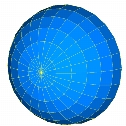
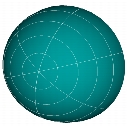
When processing the results from the radiation solver, SDB2SG distributes the results to the nodes associated with the radiation surface. SDB2SG handles SF, SE, and PR with the same basic method, simplifying algorithm strategies for models consisting of a mixture of the three methods. This process begins by creating a nodal facet representation for each radiation surface in which each radiation surface is represented as a list of nodes, with a surface area a unit normal vector for each node. After solving the radiation model, nodal facet data are used to compute the weight factors that map the radiation results back to the nodes.
The nodal facet representation is crucial to the distribution and mapping of radiation results to the nodes. For SE and PR with congruent mesh relationships, this process is straightforward, involving no fractional element faces. With fully included element faces, nodal area and normal vector calculation is simple, because the nodal area for each vertex of the element “belongs” entirely to that surface.
For non-congruent PR, fractional element faces tend to complicate things, though full element faces continue to be handled with simpler procedure used for SE and congruent PR cases. SDB2SG resorts to numerical integration for the fractional faces, and this integration process requires the selection of distribution functions. SDB2SG uses linear ramp distribution functions, though step functions were also tried with less accurate results.
SDB2SG divides fractional element faces into small areas (Gaussian integration method), and locates these integration sub-areas on the primitive surface relative to its AB mesh and parametric coordinates. This process identifies the sub-area with a daughter surface, or multiple daughters if the point falls on AB mesh grid lines. The distribution function then specifies how this bit of area is split to the nodal vertices of the element. Therefore, shared element faces cause associated nodes to include locations that actually fall outside the daughter boundary. In the nodal facet representation, the edges of the daughter surface will be “fuzzy” in the regions of shared element faces. The edge of one surface fades out while simultaneously the edge of the neighboring surface fades in. These points are illustrated in the following figure.
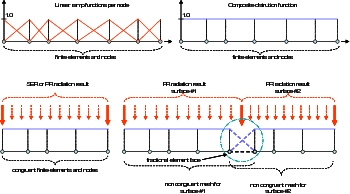
SDB2SG maps the radiation results to the nodes using the nodal facet representations of the surfaces. Orbital heating is the simplest case, being based on simple area-weighting of the results, according to the following equation.
(11‑1)

Surface to surface radiation distribution involves a more complex weighting scheme, though its basic inspiration comes from the classic integral equations used to compute view factors. The following equation shows this integration and how it is approximated from the nodal facet representation. The double summation clearly implies breaking the bulk radiation conductor down into a rank-2 matrix of size m by n; each element of the matrix being a nodal coupling, with all the couplings summing to the correct total radiation conductance.
(11‑2)

The gray body radiation conductance

between 2 surfaces is given by the following relationship. The summation will not be explicitly computed, since this result can be obtained directly from the radiation solver. Therefore, it is replaced by

which represents the reflected radiation component.
(11‑3)

The right most term in the above equation divides the conductance into the direct and reflected components, two conductors in parallel. Substituting Equations
(11‑2) into
(11‑3) gives the following.
(11‑4)

For purposes of numerical weight calculation, putting

on the same footing as

is desirable, so we can rewrite

as:
(11‑5)

In Eq.
(11‑5) 
is an unknown function. Like the view factor integration kernel,

is a function of angles, areas, and distances, but as implied in Eq.
(11‑3), the function involves all the other surfaces. Computationally, the cost of accurate

determination exceeds the cost of the radiation solution, so an approximate function must be chosen. The following constant function was chosen:

= constant.
Assuming

is similar to the kernel of the integral in Eq.
(11‑4), this effectively makes the cosine and the length terms constant, physically implying reflected radiation strikes the surface at some constant average angle and travels the same average distance. Replacing the integrals with summations and inserting Eq.
(11‑5) into Eq.
(11‑4) gives the following, which is the equation SDB2SG uses to determine the surface to surface nodal weighting factors.
(11‑6)

The

constant is chosen to ensure the second summation completes the conductance balance on

. Equation
(11‑6) plainly shows

can be divided into two matrices (size m by n) of nodal coupling – one matrix for direct and the other for reflected radiation. When no reflections take place

only the direct weights in the left summation are used. When radiation is purely by reflection (

, but

) only the right summation is used. When both modes of radiation are present

, both summations are used in proper proportions. The following three REF Distribution Method options provide controls in Patran for this method.
1. Full (default) – automatically proportions the two weighting method according to

and

from the radiation solver.
2. Area – uses only the left summation in Eq.
(11‑6), distance and viewing angle are ignored, factored to ensure the full

value is conserved; radiation will be spread evenly over the entire surfaces, including regions that are not mutually visible.
3. Direct – uses only the right summation in Eq.
(11‑6), factored to ensure the full

value is conserved; all radiation will be distributed over the mutually viewable regions of the surfaces.
When dividing PR and SE radiation to the finite element mesh, self-radiation is not ignored. SDB2SG computes the self radiation for each surface by summing all conductors to that surface, including the conductors to space. SDB2SG then performs the standard surface to surface algorithm described above to interconnect the mesh on this surface.
After all surface to surface radiation terms (including self-radiation) have been converted to inter-nodal couplings, a radiation conductance balance is performed on each node, with the remaining balance counted as conductance to space. Other than its role in computing self-radiation, the space conductors determined by the radiation solver are not used.
Each weight factor produces a conductor contribution, and all such contributions are loaded into data structures and sorted. At this state any node substitutions due to MLI modeling are performed. Sorting these data structures facilitates conversion to SINDAG Conductor Data, making it easy to combine couplings in parallel between the same 2 nodes.
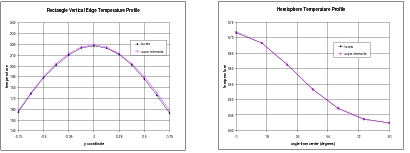
To illustrate the benefits of the weighting scheme, the following plots compare temperature results obtained for SF versus SE methods. The test case involved black body radiation between a hemisphere and a square plate. The upper-right figure shows the hemisphere profile from the pole to the equator; the down-right figure shows the temperatures along one edge of the plate. In the SF case used 288 radiation surfaces. The SE case used only 2 surfaces, both super elements. The SE radiation solution ran many times faster, yet the temperature predictions are nearly identical, even though the radiation model contained only 2 instead of 288 surfaces. The weighting method recovered the accuracy that would have otherwise been lost to the isothermal surface assumption applied to the hemisphere and plate at large. If this problem is solved using the Area Method instead of the Full or Direct Methods (described above), isothermal temperatures result for both surfaces.
Overall the SDB2SG radiation model building and results incorporation techniques provide effective methods to combine geometry-based radiation models with fine-mesh finite element representations, overcoming many difficulties traditionally preventing effective integration of these tools in the past.


